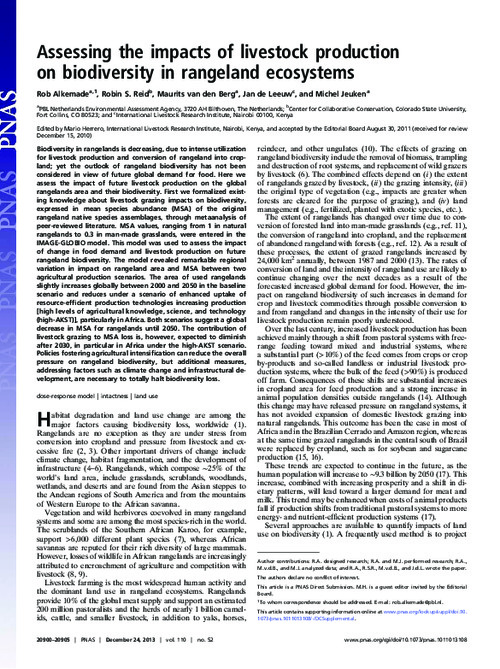Assessing the impacts of livestock production on biodiversity in rangeland ecosystems
Abstract
Biodiversity in rangelands is decreasing, due to intense utilization
for livestock production and conversion of rangeland into cropland;
yet the outlook of rangeland biodiversity has not been
considered in view of future global demand for food. Here we
assess the impact of future livestock production on the global
rangelands area and their biodiversity. First we formalized existing
knowledge about livestock grazing impacts on biodiversity,
expressed in mean species abundance (MSA) of the original
rangeland native species assemblages, through metaanalysis of
peer-reviewed literature. MSA values, ranging from 1 in natural
rangelands to 0.3 in man-made grasslands, were entered in the
IMAGE-GLOBIO model. This model was used to assess the impact
of change in food demand and livestock production on future
rangeland biodiversity. The model revealed remarkable regional
variation in impact on rangeland area and MSA between two
agricultural production scenarios. The area of used rangelands
slightly increases globally between 2000 and 2050 in the baseline
scenario and reduces under a scenario of enhanced uptake of
resource-efficient production technologies increasing production
(high levels of agricultural knowledge, science, and technology
(high-AKST)), particularly in Africa. Both scenarios suggest a global
decrease in MSA for rangelands until 2050. The contribution of
livestock grazing to MSA loss is, however, expected to diminish
after 2030, in particular in Africa under the high-AKST scenario.
Policies fostering agricultural intensification can reduce the overall
pressure on rangeland biodiversity, but additional measures,
addressing factors such as climate change and infrastructural development,
are necessary to totally halt biodiversity loss

